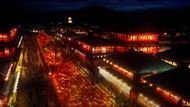Demon Slayer flares against Japan's dramatic changeover, where ancient customs clash with industrial revolution innovations. Telephone poles pierce cliffy landscapes while steam trains thunder through valleys where demons once roamed unchallenged. The series masterfully incorporates historical authenticity into its supernatural narrative, building a world where standard sword techniques meet emerging modern weaponry.
Demon Slayer is positioned in Japan's Taisho period, from 1912 to 1926. Proof from technology, fashion, and character depositions tells that the main events occurred between 1920 and 1924. This timeframe sees Japan's fast modernization while maintaining the feudal atmosphere required for the story's demon-hunting premise.
The Taisho period depicts one of Japan's most vibrant historical eras. This timeframe traverses from 1912 to 1926, drawing a crucial transition in Japanese society. Japan made big changes during this time, modernizing fast while still holding on to its traditions.

The series deliberately chooses this period to showcase contrasts between old and new Japan. Rural mountain villages where Tanjiro grew up represent traditional life. Busy cities like Tokyo show signs of Western influence. One can see it in the electric lights, cable cars, and new clothing styles.
Certain technologies in Demon Slayer help pinpoint the era it takes place. The train shown in the Mugen Train arc is based on the Class 8620 locomotive design. This type of train started being built in 1914. This detail suggests the story cannot occur before this date.
Fashion choices throughout the series also provide temporal hints. Background characters sport hairstyles and clothing typical of the early 1920s. Women's bob haircuts, which gained popularity during this decade, appear frequently in urban scenes. These visual cues point toward the 1920-1924 timeframe.

One of the most concrete timeline references comes from the Hand Demon encounter. This creature claims imprisonment for 47 years since the Keio era (1865-1868). Tanjiro mentions they are in the Taisho era. This sets the time frame for the story.
Mathematical calculations based on the Hand Demon's statements suggest events begin around 1912-1915. However, the demon's reliability as a historical witness remains questionable.
War Consideration in Demon Slayer
The absence of World War I references creates interesting timeline implications. Most able-bodied Japanese men would have faced military conscription between 1914 - 1918. The Hashira's continued demon-slaying activities suggest either that the story occurs outside these war years or that the Demon Slayer Corps operates beyond government oversight.

This facet directs many to place Demon Slayer's events before 1914 or after 1918. Incorporated with other proof, this logic backs the 1920-1924 timeline theory.
The semi-modern atmosphere allows for dramatic contrasts. Traditional swordsmanship coexists with emerging firearms technology. The ancient demon threats face humanity's advancing capabilities. This conflict pushes several of the show’s main ideas.
Tanjiro's aging, as the story goes on, hints at the series' timeline. He starts his journey at age 13 and is 16 by the time the final battles take place. The story spans roughly three years from start to finish. If Tanjiro's birth year is 1900, the major events would happen between 1913-1916. Anyway, this contradicts some technological evidence, resulting in ongoing recorded inconsistencies.
The willful ambiguity about exact dates aids Demon Slayer's storytelling purposes. Rather than focusing on documented accuracy, the series prioritizes effusive will and thematic depth. The Taisho era equips an aura without depriving the narrative. The setting adds depth to the story but doesn’t take the spotlight away from the characters.
In summation, while Demon Slayer never explicitly reveals its exact year, evidence suggests the early 1920s within the Taisho era. The variety of technological references, fashion segments, and character testimonies indicates 1920-1924 as the most feasible timeframe. Yet, the precise year matters less than how this historical setting enhances the story's spirited impact.
